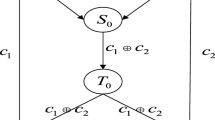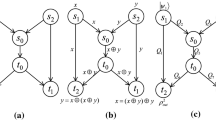Abstract
Quantum network coding with the assistance of auxiliary resources can achieve perfect transmission of the quantum state. This paper suggests a novel perfect network coding scheme to efficiently solve the quantum k-pair problem, in which only a few assisting resources are introduced. Specifically, only one pair of maximally entangled state needs to be pre-shared between two intermediate nodes, and only O(k) of classical information is transmitted though the network. Moreover, the classical communication used in our protocol does not cause transmission congestion, providing better adaptability to large-scale quantum k-pair networks. Through relevant analyses and comparisons, we demonstrate that our proposed scheme saves resources and has good application value, thereby showing its high efficiency. Furthermore, the proposed scheme achieves 1-max flow quantum communication, and the achievable rate region result is extended from its counterpart over the butterfly network.
Similar content being viewed by others
References
Ahlswede R, Cai N, Li S Y R, et al. Network information flow. IEEE Trans Inform Theor, 2000, 46: 1204–1216
Li S Y R, Yeung R W, Cai N. Linear network coding. IEEE Trans Inform Theor, 2003, 49: 371–381
Ding L H, Wu P, Wang H, et al. Lifetime maximization routing with network coding in wireless multihop networks. Sci China Inf Sci, 2013, 56: 022303
Zhang C S, Ge J H, Li J, et al. Robust power allocation algorithm for analog network coding with imperfect CSI. Sci China Inf Sci, 2014, 57: 042312
Guo R N, Zhang Z Y, Liu X P, et al. Existence, uniqueness, and exponential stability analysis for complex-valued memristor-based BAM neural networks with time delays. Appl Math Comput, 2017, 311: 100–117
Pang Z, Liu G, Zhou D, et al. Data-based predictive control for networked nonlinear systems with packet dropout and measurement noise. J Syst Sci Complex, 2017, 30: 1072–1083
Li L, Wang Z, Li Y, et al. Hopf bifurcation analysis of a complex-valued neural network model with discrete and distributed delays. Appl Math Comput, 2018, 330: 152–169
Shen H, Song X, Li F, et al. Finite-time L2 − L∞ filter design for networked Markov switched singular systems: a unified method. Appl Math Comput, 2018, 321: 450–462
Shin W Y, Chung S Y, Lee Y H. Parallel opportunistic routing in wireless networks. IEEE Trans Inform Theor, 2013, 59: 6290–6300
Bell J S. On the Einstein Podolsky Rosen paradox. Phys Physique Fizika, 1964, 1: 195–200
Gisin N. Bell’s inequality holds for all non-product states. Phys Lett A, 1991, 154: 201–202
Popescu S, Rohrlich D. Generic quantum nonlocality. Phys Lett A, 1992, 166: 293–297
Dong H, Zhang Y, Zhang Y, et al. Generalized bilinear differential operators, binary bell polynomials, and exact periodic wave solution of boiti-leon-manna-pempinelli equation. In: Proceedings of Abstract and Applied Analysis, Hindawi, 2014
Jiang T, Jiang Z, Ling S. An algebraic method for quaternion and complex least squares coneigen-problem in quantum mechanics. Appl Math Comput, 2014, 249: 222–228
Chaves R. Polynomial bell inequalities. Phys Rev Lett, 2016, 116: 010402
Rosset D, Branciard C, Barnea T J, et al. Nonlinear bell inequalities tailored for quantum networks. Phys Rev Lett, 2016, 116: 010403
Gisin N, Mei Q, Tavakoli A, et al. All entangled pure quantum states violate the bilocality inequality. Phys Rev A, 2017, 96: 020304
Luo M X. Computationally efficient nonlinear bell inequalities for quantum networks. Phys Rev Lett, 2018, 120: 140402
Hu M J, Zhou Z Y, Hu X M, et al. Experimental sharing of nonlocality among multiple observers with one entangled pair via optimal weak measurements. 2016. ArXiv: 1609.01863
Hayashi M, Iwama K, Nishimura H. Quantum network coding. In: Proceedings of the 24th Annual Conference on Theoretical Aspects of Computer Science. Berlin: Springer, 2007. 610–621
Tang X H, Li Z P, Wu C, et al. A geometric perspective to multiple-unicast network coding. IEEE Trans Inform Theor, 2014, 60: 2884–2895
Harvey N J, Kleinberg R D, Lehman A R. Comparing Network Coding with Multicommodity Flow for the k-pairs Communication Problem. MIT LCS Technical Report 964. 2004
Dougherty R, Zeger K. Nonreversibility and equivalent constructions of multiple-unicast networks. IEEE Trans Inform Theor, 2006, 52: 5067–5077
Curty M, Lewenstein M, Lütkenhaus N. Entanglement as a precondition for secure quantum key distribution. Phys Rev Lett, 2004, 92: 217903
Ren X. Quantum correlations generation and distribution in a universal covariant quantum cloning circuit. Sci China Inf Sci, 2017, 60: 122501
Bennett C H, Brassard G, Crépeau C, et al. Teleporting an unknown quantum state via dual classical and Einstein-Podolsky-Rosen channels. Phys Rev Lett, 1993, 70: 1895–1899
Chen X B, Su Y, Xu G, et al. Quantum state secure transmission in network communications. Inf Sci, 2014, 276: 363–376
Dou Z, Xu G, Chen X B, et al. A secure rational quantum state sharing protocol. Sci China Inf Sci, 2018, 61: 022501
Hayashi M. Prior entanglement between senders enables perfect quantum network coding with modification. Phys Rev A, 2007, 76: 040301
Ma S Y, Chen X B, Luo M X, et al. Probabilistic quantum network coding of M-qudit states over the butterfly network. Opt Commun, 2010, 283: 497–501
Satoh T, Le Gall F, Imai H. Quantum network coding for quantum repeaters. Phys Rev A, 2012, 86: 032331
Satoh T, Ishizaki K, Nagayama S, et al. Analysis of quantum network coding for realistic repeater networks. Phys Rev A, 2016, 93: 032302
Zhang S, Li J, Dong H J, et al. Quantum network coding on networks with arbitrarily distributed hidden channels. Commun Theor Phys, 2013, 60: 415–420
Mahdian M, Bayramzadeh R. Perfect k-pair quantum network coding using superconducting qubits. J Supercond Nov Magn, 2015, 28: 345–348
Li J, Chen X B, Sun X M, et al. Quantum network coding for multi-unicast problem based on 2D and 3D cluster states. Sci China Inf Sci, 2016, 59: 042301
Wang F, Luo M X, Xu G, et al. Photonic quantum network transmission assisted by the weak cross-Kerr nonlinearity. Sci China-Phys Mech Astron, 2018, 61: 060312
Shang T, Li K, Liu J. Continuous-variable quantum network coding for coherent states. Quantum Inf Process, 2017, 16: 107
Nguyen H V, Babar Z, Alanis D, et al. Towards the quantum Internet: generalised quantum network coding for large-scale quantum communication networks. IEEE Access, 2017, 5: 17288–17308
Li D D, Gao F, Qin S J, et al. Perfect quantum multiple-unicast network coding protocol. Quantum Inf Process, 2018, 17: 13
Nielsen M A, Chuang I L. Quantum Computation and Quantum Information. 10th ed. New York: Cambridge University Press, 2010
Kobayashi H, Le Gall F, Nishimura H, et al. General scheme for perfect quantum network coding with free classical communication. In: Proceedings of the 36th International Colloquium on Automata, Languages and Programming, Greece, 2009. 622–633
Kobayashi H, Le Gall F, Nishimura H, et al. Constructing quantum network coding schemes from classical nonlinear protocols. In: Proceedings of the IEEE Int Symp Information Theory (ISIT), New York, 2011. 109–113
Li J, Chen X B, Xu G, et al. Perfect quantum network coding independent of classical network solutions. IEEE Commun Lett, 2015, 19: 115–118
Yang Y, Yang J, Zhou Y, et al. Quantum network communication: a discrete-time quantum-walk approach. Sci China Inf Sci, 2018, 61: 042501
de Beaudrap N, Roetteler M. Quantum linear network coding as one-way quantum computation. 2014. ArXiv: 1403.3533
Kobayashi H, Le Gall F, Nishimura H, et al. Perfect quantum network communication protocol based on classical network coding. In: Proceedings of the IEEE Int Symp Information Theory, New York, 2010. 2686–2690
Leung D, Oppenheim J, Winter A. Quantum network communication-the butterfly and beyond. IEEE Trans Inform Theor, 2010, 56: 3478–3490
Nishimura H. Quantum network coding–how can network coding be applied to quantum information? In: Proceedings of the 2013 IEEE International Symposium on Network Coding, 2013. 1–5
Jain A, Franceschetti M, Meyer D A. On quantum network coding. J Math Phys, 2011, 52: 032201
Acknowledgements
This work was supported by National Natural Science Foundation of China (Grant Nos. 61671087, 61272514, 61170272, 61003287, 61373131), the Fok Ying Tong Education Foundation (Grant No. 131067), and the Major Science and Technology Support Program of Guizhou Province (Grant No. 20183001).
Author information
Authors and Affiliations
Corresponding author
Rights and permissions
About this article
Cite this article
Li, ZZ., Xu, G., Chen, XB. et al. Efficient quantum state transmission via perfect quantum network coding. Sci. China Inf. Sci. 62, 12501 (2019). https://doi.org/10.1007/s11432-018-9592-9
Received:
Accepted:
Published:
DOI: https://doi.org/10.1007/s11432-018-9592-9




